Q&A – Ask Neil: April 4, 2024
(Please read these instructions carefully.)
Before you post your question, please look at recent issues to see if someone else has already asked it. You might find your answer there.
How to submit your question…
(Note: You may need to allow a pop-up window to come up in order to get the link for sending your photo(s). If you have already submitted your question and didn’t see the pop-up window, please click here.)
• Click the link provided below to post your question. After you submit your question, a new window will pop up giving you the address to which you can e-mail a SHARP, HIGH-RESOLUTION PHOTO to accompany your question. Please DO NOT SEND THUMBNAIL PHOTOS in case I need to zoom in to see things.
• Click here to post your question.
• Please ONLY POST YOUR QUESTION ONE TIME. We can only accept a set number of questions each week, and when we get duplicates it costs other people their chances.
• One question per reader, please.
• Please use this only for posting questions – not for standard emails.
• Watch for your answer in the following week’s e-gardens.
• I choose those of greatest general interest. For example, plant IDs seldom make the cut.
• I must have your first name or initials.
• I must have your city or county. (Texas is a very large state.)
QUESTION 1
CAN A VOLUNTEER CRAPE MYRTLE BE MOVED?
Question: I have a volunteer crape myrtle that came up 2 or 3 years ago probably 5 feet from my house. It’s 4 feet tall and spreading. Can I transplant it? Marianne D., Bells, Grayson County.
Answer: Yes. The best time would be mid-winter while it is completely dormant. Crape myrtles are forgiving, however, so if you must move it before next winter, do so immediately (before it grows any more this spring). Hold the soil around its roots as you dig and replant it immediately. Prune to compensate for the roots lost in the digging – probably removing 30 to 40 percent of its top growth. Water deeply immediately after you finish the planting.
QUESTION 2
HOW CAN WE TRIM OUR AGAVES?
Question: If we trim to remove the ragged leaves from our century plants they will probably look ragged and have gaps at their bases. What should we do? Buddy W., Georgetown.
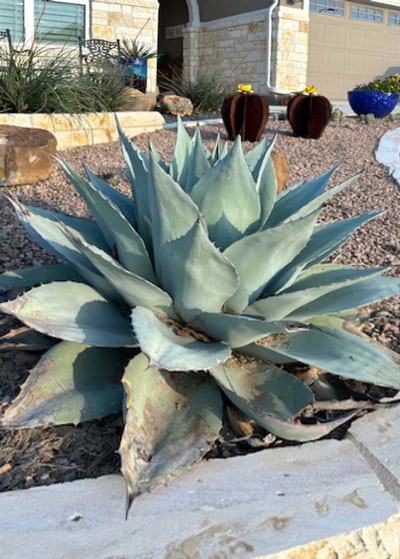
Answer: Trim the bottom-most leaves off since they look quite bad but leave the rest. As the new leaves are produced, they will extend out and over these ragged ends. You probably won’t even notice this in a few months.
QUESTION 3
PLEASE HELP WITH RESEEDING ADVICE.
Question: When can I reseed my lawn with bermudagrass seed after I kill all the broadleafed weeds? How often should I fertilize, and what fertilizer is best for a lawn of mixed St. Augustine and bermuda? Does a live oak need fertilizer? Olga G-O, Collin County.
Answer: Bermuda seed needs warm soil, so late April, better yet May in Collin County (where I also live). Fertilize bermuda where you are in early April, early June, early August, and early October. St. Augustine mid-April, early June, and early September. All-nitrogen with 30 to 40 percent of the N in slow-release form. Same fertilizer on live oaks as part of your lawn feeding. Be sure it does not contain a weedkiller material.
QUESTION 4
WHAT GROUNDCOVER WOULD BE BEST BENEATH PECANS?
Question: I have three large pecans that drop catkins in spring, pecans and leaves in fall, and a lot of other debris. What do you suggest as a groundcover? Chris R., Dallas County.
Answer: I have used exclusively regular mondograss beneath our pecans. It has a fine texture and no stems to hook the leaves or catkins. I can easily blow all the fallen debris out of the groundcover beds. I am totally satisfied. Plant fist-sized clumps into well-prepared soil 8 or 10 inches apart and it will spread to cover within the first growing season.
QUESTION 5
WHAT WILL KILL VIRGINIA CREEPER IN MONKEYGRASS?
Question: Is there anything that will kill Virginia creeper in my monkeygrass bed without killing the monkeygrass? Faylene H., Ben Wheeler.
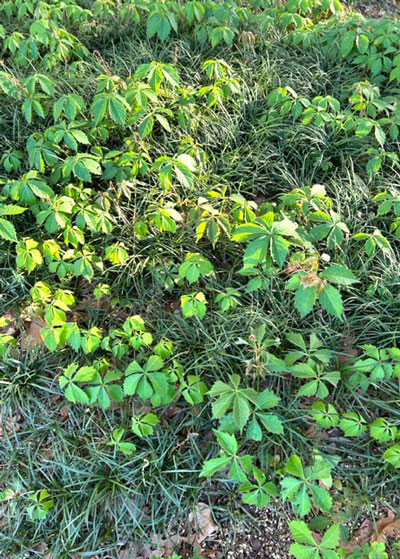
Answer: With all the conviction in my heart, I will say that you really need to eliminate this by pulling it out. You could rid this entire bed within 5 minutes with just your hand and a glove. It rarely roots into the ground, and the stems come loose very easily. Yes, more seedlings will germinate and a few of these sprouts will regrow from tiny pieces that get left behind, but with this vine, pulling is 50 times easier (and safer) than spraying!
QUESTION 6
DIMENSION HASN’T WORKED ON THIS CHICKWEED. HELP!
Question: I have been applying pre-emergent Dimension at the recommended times the last few years to prevent germination of chickweed, but it’s not working. Is chickweed another weed that is becoming resistant to pre-emergents? Steve R., Arlington.
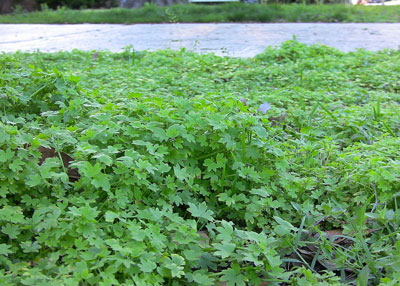
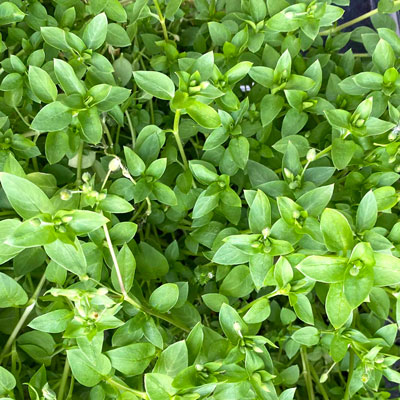
Answer: Where shall I start? First, this isn’t chickweed. I’ve posted a photo of chickweed for your comparison. This is Bowlesia incana, “commonly” known as “hoary bowlesia,” although I used quotes around “commonly” because there are many of us out there who don’t instantly recognize this weed. (Thanks to John Langevin for rescuing me!)
Here is a thorough write-up on it from a non-university website. It does have ads and the source is selling a book along this topic, but he’s so thorough with the ID that I felt it was too good to pass up. Note that a close look-alike is poisonous, so be forewarned.
This is a cool-season, broadleafed weed, so pre-emergents like Dimension, Halts and Balan that I normally recommend would not be as effective as they would be on winter grasses. You should use Gallery granules applied the first week of September. It is intended for use as a preventive against non-grassy weeds like this. Actually, I would recommend applying a broadleafed weedkiller containing 2,4-D as soon as possible to get rid of this spring’s crop before it can go to seed.
QUESTION 7
ARE THESE HOLLY LEAVES A CONCERN?
Question: My new 30-gallon Nellie R. Stevens holly planted last October is showing these yellow leaves with black spots. Is this a concern? Carol V., McKinney.
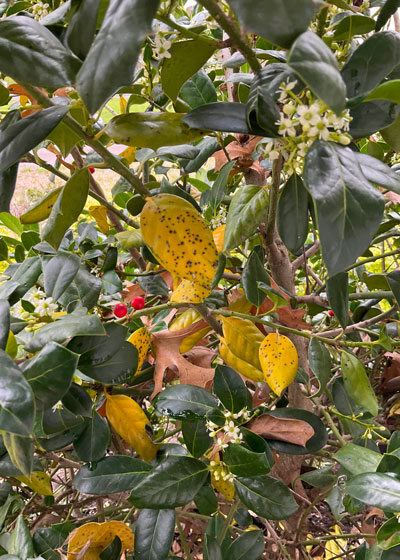
Answer: These are last year’s leaves getting ready to shed and be replaced by new growth. Absolutely not any concern. I have probably 200 different hollies doing the same thing. (Your plant thanks you for being so observant. Continue that on in terms of its water needs this late spring and summer. Watch very closely for signs of dry soil. Learn what the holly looks like when it needs water, then soak it thoroughly. I would recommend you give it 30 gallons every two days once it gets up into the 90s each day.)
